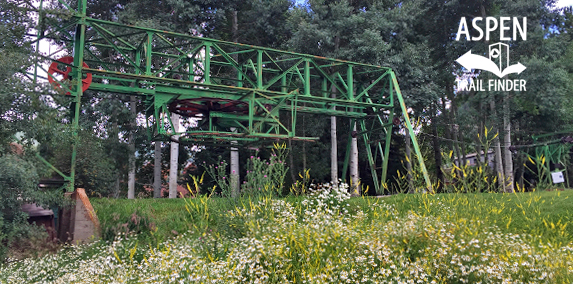Connects: Lift 1 Park, Willoughby Park, Lift 1 Park
![]()
![]()
![]()

Ski Lift No. 1 in Aspen
Aspen, CO – Historic
Ski Lift No. 1 is Aspen’s first ski lift, known as the Boat Tow. This ski lift can be found in Lift 1 Park near Willoughby Park. The Boat Tow is listed on the National Register of Historic Places.
More information can be found at:
National Park Service – National Register of Historic Places – Boat Tow
Wikipedia – Ski Lift No. 1
“The Longest Ski Lift In The World”
Construction began June 24, 1946
Left began operation: December 14, 1946
Dedication: January 11, 1947
Last day of operation: April 11, 1971
Aspen Historical Society”
In 1946, the Aspen Skiing Company began to build what was then the world’s longest chairlift. Built in two sections, the first section, known as Lift 1, opened on December 14, 1946. Use of the lift ended in 1971, with all but the lower terminal and three adjacent towers removed. The remaining structure is an Aspen landmark and is listed on the National Register of Historic Places.
The City of Aspen has recently commissioned an expert study on the condition of the lift and recommendations for treatment. Essential repairs will be completed in the summer of 201. The City has temporarily removed some of the original chairs and placed them in secure storage until the repair work is completed, to avoid damage to these artifacts.
For further information, contact Amy Simon, City of Aspen Historic Preservation Officer at amy.simon@cityofaspen.com“
These were constructed of pine, including the runners, to which steel banding was attached and which is still in place. One of the boat tow toboggans, a designated local landmark, is currently on permanent display in the center of Willoughby Park, located immediately adjacent to Tower #1 of Lift 1, the first chair lift in Aspen. The display platform is approximately two feet high, constructed of two rows of wood railroad ties, filled in with soil and planted with grass. This display is the focal point of Willoughby Park.
The toboggan “boat,” is located directly in the center of the platform, and is displayed at an approximately 30% angle, elevated at the front end by a round metal pipe forming an inverted “U”. The “boat” shows signs of deterioration, particularly in the seats, which have cracks and portions missing, but its basic design is readily apparent.
The Boat Tow utilized old mining equipment. The “boats” were connected by 1/2″ steel cable to rotating terminals converted from hoist rigs from the dormant Little Annie Mine on Aspen Mountain. The steel cable was guided up the mountain by wood towers to prevent tangling. The motor was ac converted Model A Ford engine; the total length of the boat tow was 600′ up the face of Aspen Mountain.
None of the original cable, towers or mechanical equipment is still located on the original site. It is unknown whether any of the original equipment exists with the exception of the second “boat”, owned by Aspenite Steve Knowlton.
The Boat Tow, constructed in 1937, located in Aspen, Colorado, meets Criterion A in its association with the beginning development of Aspen as an international ski resort from 1936-1940, and under Criterion C for its contribution to the technological advancement of the construction of recreational ski transportation.
Following the discovery of Aspen’s unique topography and excellent winter conditions ideal for skiing, by developers Billy Fiske (Olympic bob sled champion) and capitalist Ted Ryan in 1936, the “Boat Tow” ski lift was constructed in 1937. The Aspen Lions Club, an earlier promoter of the Aspen area, had raised the $600.00 necessary to purchase a length of half-inch steel cable for the lift, and it was constructed by members of the Aspen Ski Club. The motor, a converted Model A Ford engine, was donated by Laurence Elisha, owner of the Hotel Jerome. The rotating terminals were converted hoist rigs from the Little Annie Mine. Two toboggans, or “boats”, (modeled after a similar tow Ted Ryan had seen in Kitzbuhel, Austria in 1935) were attached to the cable; up to four people could sit inside a boat and be pulled to “the top” (600′) in less than three minutes while the other, empty “boat” slid down the other side.
Wooden “towers” guided the cable to the top of the tow. The fee was 10 cents a ride, 50 cents for a half day. The official opening day was January 27, 1938. One hundred people rode Colorado’s biggest ski lift that day.”

























